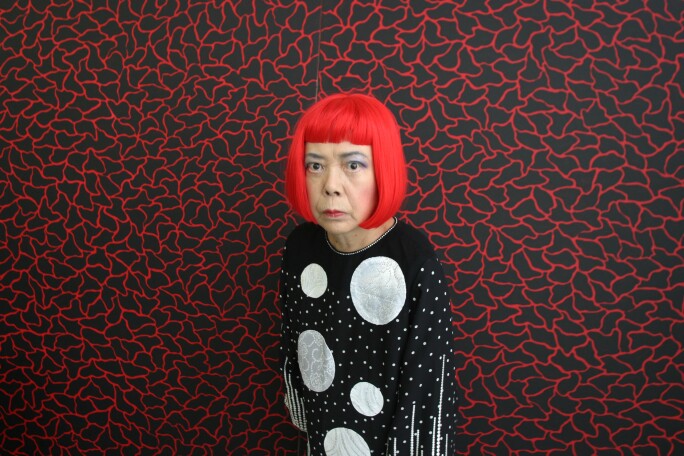"I want to obliterate and efface the gloom of the end of the century and open a shining door to the 21st Century with my own hand, hoping for the hymn of ever-shining life to continue beyond the quietude of death."
The Moment of Regeneration is a singularly iconic and monumental work epitomizing Yayoi Kusama’s stellar ascent into international prominence in the twenty-first century. In equal parts exuberantly fantastical and whimsically ominous, the spectacular installation features an unruly mass of scarlet appendages that sprout and bloom from the ground, roaming and reaching like sinister tentacles. Utterly distinctive, the work was a key highlight when it was exhibited in numerous of Kusama’s most prestigious museum retrospectives that travelled around the world in the decade after its creation. Explosive in originality, manifesting a wholly unique visual phenomenon, The Moment of Regeneration is a glorious paradigm of Yayoi Kusama’s legendary creative journey, magnificently emblematic of her internationally celebrated and consistently radical, transformative and accomplished oeuvre.


Yayoi Kusama’s critically acclaimed sculptures were first unveiled to the world in the early 1960s, at the height of her whirlwind emergence in the New York art scene. In the midst of the debut of her Infinity Net paintings at important group and solo shows in New York, Chicago, Washington and Pittsburgh, as well as the Whitney Annual Exhibition, the Stedelijk Museum in Amsterdam and the Nieuwe Tendenzen exhibition in Leiden, Kusama moved into a new studio at 53 East 19th Street. Importantly, this building was already occupied by the young sculptor, critic and collector Donald Judd, a friend of Kusama’s. Six months after this move, in June 1962, Kusama participated in a group show at Green Gallery, exhibiting together with rising luminaries Andy Warhol, Robert Morris, Robert Whitman, Claes Oldenburg and James Rosenquist. For the exhibition, Kusama presented a sensational new direction in her work, her soft sculptures, producing an armchair and couch completely covered with stuffed phallic protuberances. One year later, her revolutionary Aggregation: One Thousand Boats Show at Gertrude Stein Gallery in December 1963 saw Kusama invading the entire gallery space with her compulsive phallic sculptures installed on a rowing boat, which was engulfed by and immersed within repeating photographic images of the same vessel. Mesmerizing, menacing, mischievous and charged with erotic energy, the alluring power of Kusama's uncanny installation was raved about by the likes of Warhol and American critic Brian O’Doherty, who described Kusama's art as the production of both object and environment.
On these extraordinary sculptures and installations of obsessively repeating forms, Kusama has remarked: “I make them and make them and then keep on making them, until I bury myself in the process. I call this process ‘obliteration’”.
“As with her paintings, Kusama continued to ‘cover’ the works surfaces with a dense and more or less uniform pattern, but in place of the scalloped net motif with all its multiple evocations here were emphatically domestic objects covered in unmistakably phallic protuberances, a bizarre macho invasion of the citadel of domestic femininity, the home, hilarious and hideous at one and same time.”
Morris continues that Kusama’s ability to “marry seemingly incompatible sensibilities – the ‘seriality’ we associate with Minimalism, the ‘uncanny’ of Surrealism and its fetishization of the body part, the junk aesthetic of assemblage, as well as the active participation of the happening – reinforced Kusama’s special status at this time as an outsider on the inside” (Ibid). Such cutting-edge accomplishments propelled the rise of her status within the New York art scene, establishing herself as an authentic new voice in Europe and the United States and garnering critical attention from some of the most noted critics and dealers of the day.

The Moment of Regeneration, created in 2004, is a large-scale sculptural installation evolving from Kusama's incipient 1960's soft sculptures: while resembling the appearance of her soft sculptures, the present work is in fact created with painted fabric over wood and embodies a hard texture. The iconic piece emerges from the pivotal and uplifting 2000s era of Kusama’s legendary career: after an explosive rise to stardom in New York, Kusama retreated into a psychiatric hospital in Japan in 1975, withdrawing into two decades of semi-obscurity whilst quietly amassing an extraordinarily prolific body of work. Kusama's international revival began at the 1993 Venice Biennale when she constructed a dazzling mirror room filled with pumpkin sculptures for the Japanese pavilion, Kusama reminded the world of the enduring brilliance of her aesthetic and ignited her swift and phenomenal rise to immortal stardom. Morris observes: “This was a period in which the phalli of her Accumulations mutated into large-scale multi-part sculptures with tendril-like writhing appendages” (Ibid, p. 200).
Created in 2004, by which time Kusama had become a global household name, the aptly titled The Moment of Regeneration emblematizes the artist’s international resurgence, standing as a symbol of triumph for the artist’s personal and artistic rebirth; as Alexandra Munroe writes, Kusama’s art requires her “not only to surrender to madness but also to triumph over it; trauma must be substantially transformed before it can communicate to others as beauty and meaning” (Alexandra Munroe, ‘Between Heaven and earth: The Literary Art of Yayoi Kusama’, in Exh. Cat. Love Forever: Yayoi Kusama 1958-1968, Los Angeles County Museum of Art, 1998, p. 81).









